Taken athlete by athlete, it can be hard to determine a typical trajectory in a gymnast’s career. We wanted to know, when we break it down by the numbers, are there commonalities across the careers of college gymnasts? To understand when gymnasts typically peak during their college gymnastics career, we asked ourselves many questions. Do gymnasts compete more often or score their highest in a particular class year? Do those patterns differ depending on the event in question? Do specialists tend to peak during different points in their college careers than all–arounders do? Are these patterns similar across teams?
To determine the answers, we looked at two different sets of numbers: lineup appearances and National Qualifying Scores (NQS).
Do gymnasts peak in lineup appearances in a particular class year?
To dive into lineup appearance trends, we looked at individual scores from meets between 2010 and 2022. Since we were interested in when individual performances tend to peak within a collegiate career, we removed gymnasts whose full four years of competition did not fall within the window between 2010 and 2022. For example, a gymnast who was a first-year in 2022 was not included, nor was a gymnast who was a third-year in 2010. Gymnasts whose freshman year was in 2010 were included, as well as gymnasts whose fourth year was in the 2022 season.
The number of appearances each gymnast made on an event was aggregated from individual meet results. We then found the class year that each gymnast made the most lineup appearances on each event: first, second, third, or fourth. For this data deep dive, fifth years were considered fourth years. Percentages in the charts below are based on the total number of gymnasts with at least one appearance on the event.
First, we looked at all gymnasts whose careers nested within 2010 and 2022 and found the class year in which they had their highest lineup frequency on each event. Gymnasts with more than one highest-appearance year were excluded from the chart below. Across all four events, it was most common for gymnasts’ highest lineup frequency to happen in their first year. In the all–around, 52% of gymnasts competed in the all–around most frequently during their first or second year.
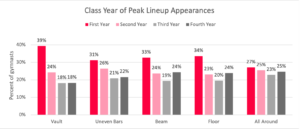
Next, we created a subset of gymnasts who competed for at least four years and found the year in which they competed the highest number of routines on each apparatus. Gymnasts with more than one peak-appearance season were excluded.
On vault, 30% of gymnasts who competed at least once in college competed most often during their freshman season. On all other events, as well as in the all–around, gymnasts made lineups most frequently in their senior season.

To see if the pattern holds for specialists, we looked at gymnasts who did not compete more than five times per season on any event other than their specialty. We then aggregated the year of each gymnast’s highest number of appearances on their event.
Specialists who primarily competed on beam and floor tended to peak in lineup appearances during their fourth year. Bar specialists most often competed with the highest amount of frequency in their second year. Vault appearances were more closely distributed across classes.
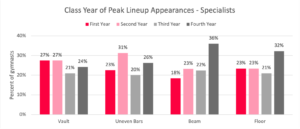
Next, we wanted to see if gymnasts on different teams had differing peak-appearance seasons. For each apparatus, we aggregated the number of four-year gymnasts who had a single peak-lineup year and found the year gymnasts most frequently peaked on each team. Next, we aggregated teams with the same peak appearance years. Teams with more than one peak-appearance class were excluded.
On bars (30%), beam (44%), and floor (44%), teams most often had fourth-year athletes peak in number of appearances. On vault, 38% of teams had gymnasts compete most frequently in their first year.
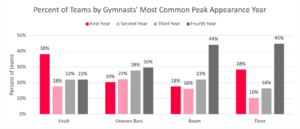
All in all, after controlling for gymnasts who competed for less than four years, years of peak lineup appearances were closely distributed between all four class years, with vault appearances most often peaking during freshman seasons while other apparatus appearances peaked during senior seasons. Specialists peaked differently: slightly more than half of vault and bar specialists were in lineups most frequently in their first or second years, while for beam and floor specialists, more gymnasts peaked in appearances in the latter two years. Teams differed in the years their gymnasts’ lineup frequency peaked.
Do gymnasts peak in NQS in a particular class year?
Similar to the above process that we used to analyze appearances, we found the class year in which gymnasts had their highest NQS on each event. We removed gymnasts whose four years did not fall within the time period from 2010 to 2022. The percentages shown in the charts below are based on the total number of gymnasts with at least one NQS on the event.
We started by looking at gymnasts who competed for any number of years. The chart below shows the class year in which gymnasts achieved their highest NQS. If a gymnast had more than one year with the same high NQS, they were not included in this part of the analysis (about 2% of gymnasts were excluded).
On vault, 26% of gymnasts achieved their highest NQS in their first season, 25% in their second, 22% in their third, and 27% in their fourth. Bars, beam, and floor had similar patterns: about 19% of gymnasts achieved their highest NQS in their first season, about 22% in their second, about 25% in their third, and about 34% of gymnasts had their highest NQS in their fourth year.
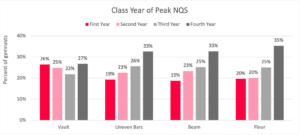
Next, we excluded gymnasts who competed for less than four years. For gymnasts who competed for at least four years and had at least one NQS on an event, we looked at the number of seasons in which the gymnast received an NQS on an event. Across all events, about 30% of gymnasts had an NQS in four different years.
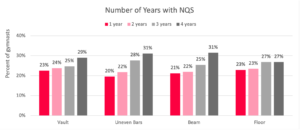
On all events, four-year gymnasts most frequently achieved their highest NQS during their fourth year. Vault peak seasons were more closely distributed than the other three events, perhaps due to less separation in vault scoring: 18% of gymnasts achieved their highest NQS in their first season and 32% in their fourth. On uneven bars, beam, and floor, about 12% of gymnasts had their highest NQS in their first year and about 40% of gymnasts had their highest NQS in their fourth year.
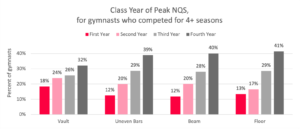
To look at event specialists’ peak NQS, we created a subset of gymnasts who had an NQS on only one event throughout their career and determined the year of their highest NQS on their event. On vault and floor, specialists most often achieved their highest NQS in their fourth year. On bars and beam, specialists most frequently had their highest NQS in their first year.

To see if trends differed across teams, we found the most frequent year in which four-year gymnasts on each team achieved their peak NQS on each apparatus. Gymnasts with the same peak NQS in more than one year and teams with more than one peak class on an apparatus were excluded from the analysis.
On all four events, teams had gymnasts achieve their peak NQS in their fourth year most frequently. This was most apparent on floor, where 71% of teams had gymnasts most frequently achieve their highest NQS in their fourth year, 22% in their third year, 3% in their second year, and 4% in their first year. Bars and beam had a similar distribution – gymnasts most frequently had their highest NQS in their fourth season on most teams; about 1 in 4 teams had gymnasts with peak NQS in their third season; and just a handful of teams most frequently had gymnasts achieve peak NQS in their first or second year.
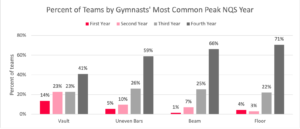
Overall, more gymnasts had their peak NQS season in their fourth year than in any other season. However, this was not an authoritative peak – more than half of gymnasts achieved their peak NQS in years one, two, or three. For bar specialists and beam specialists, the opposite was true: gymnasts most frequently had their highest NQS in their first season. There wasn’t much variation between teams: on most teams, gymnasts most frequently achieved their peak NQS in the latter half of their career.
Do peak appearance years coincide with peak NQS years?


To compare peak appearances and peak NQS class years, we created heatmap tables for each apparatus. To make these tables, we included four-year gymnasts who had a single-year peak in appearances and a single-year peak in NQS during the same season. In general, peak NQS and peak-lineup appearances did coincide (i.e. gymnasts had their highest NQS and highest number of lineup appearances in the same season): 74% of gymnasts who competed on vault, 73% on bars, 73% on beam, and 66% on floor had both peaks in the same season. We also found that gymnasts had peak appearance seasons come after peak NQS seasons 16% of the time on vault, 20% on bars, 19% on beam, and 26% on floor. For 10% or less of gymnasts, peak appearance seasons happened prior to achieving their peak NQS on that event.
Overall, looking at the gymnasts who fit our criteria, we found that there are patterns to when athletes peak – both in competition appearances as well as scoring potential. Although the data told different stories between all–arounders and specialists, we found that peaks existed within both groups and sometimes differed between events. While gymnastics, like all sports, is unpredictable, the information we gathered here could help you if you’re looking for a new approach to predict how often and how well athletes will perform this season.
READ THIS NEXT: Data Deep Dive: Determining the All-Time Greats
Article by Jill Walsh and Dara Tan

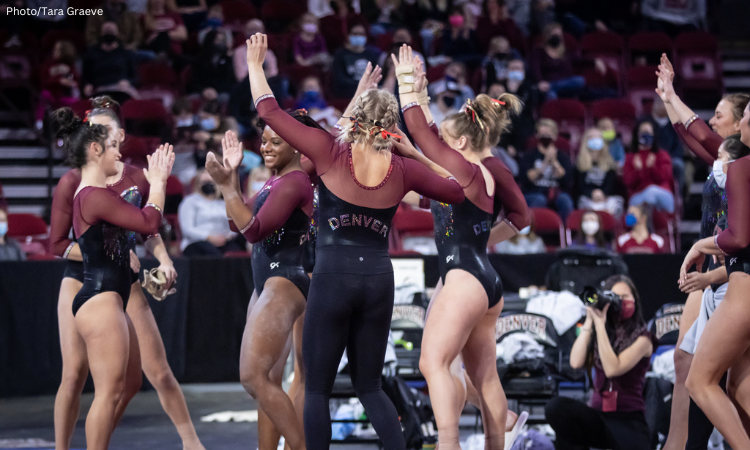



3 comments